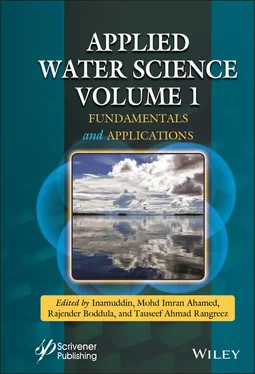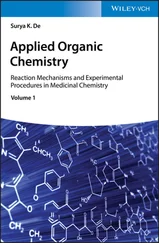1 ...7 8 9 11 12 13 ...27 MeOHMeOHMeOHMeOHMeOH

Figure 1.5Scheme of a similar extraction procedure carried out by Chen et al. [75] using the same (β-CD-PNIPAM temperature-sensitive polymer as extractant for the determination of phenolic compounds in river water samples. Reprinted from [75] with permission of Elsevier. Peak identification: phenol (BP), 2,4-dichlorophenol (2,4-DCP), (β-naphthol ((β-NP), and bisphenol A (BPA).
Despite the simplicity of the dSPE, the whole procedure can be even improved and simplified if the sorbent particles can be manipulated with a magnet. Such dSPE mode is called m-dSPE and is based on the use of magnetic NPs (m-NPs), which can be applied as synthesized (though in very few cases), although they are generally functionalized or coated with other chemical species or materials, resulting in many cases a “coreshell” structure, in order to improve their selectivity, or even embedded them in the extraction sorbent to provide it with magnetic properties [50]. Despite the extraction step is performed in a similar way as in dSPE, in this case, the magnetic sorbent containing the analytes is retained in the extraction recipient using an external magnet while the sample matrix is easily discarded without the need of an additional centrifugation step or the retention of the sorbent in an empty column. Finally, the analytes are desorbed from the magnetic sorbent using a suitable solvent and, once more, the sorbent is retained with the magnet to separate the solvent containing the analytes by decantation for their determination with a suitable technique.
Although a wide variety of metals, metal oxides and alloys can be used to provide magnetic properties to the sorbent, Fe 3O 4NPs have been used as the main support with this purpose due to their extraordinary magnetic features and the possibility of being modified by anchoring certain chemical species or materials to obtain sorbents that provide different selectivity. Therefore, as in the rest of the sorbent-based microextraction techniques, the preparation of appropriate sorbents is one of the most important aspects to be considered. In this regard, carbon-based nanomaterials like MWCNTs [76, 77] and graphene [26, 78, 79], combined with m-NPs have once again been one of the most used for the extraction of PAEs from water samples due to their well-known properties in terms of high surface area-to-volume ratio that guarantees high extraction efficiency. As an example, MWCNTs were functionalized via chemical modification by Jiao et al. [76]. Figure 1.6 shows the scanning electron microscopy and transmission electron microscopy images of m-NPs successfully combined with MWCNTs. The authors used this sorbent to study a large set of thirteen PAEs, paying special attention to the elution step because PAEs may not be easily desorbed due to the strong interaction between the sorbent and analytes. For this purpose, different common organic elution solvents (i.e., acetone, MeOH, n-hexane, ethyl acetate, and toluene) were evaluated, finding that the use of toluene provided higher recovery percentages compared to non-aromatic solvents, particularly for BBP and diphenyl phthalate (DPhP), since they contain two and three benzene rings, respectively. However, since toluene is highly toxic, toluene-acetone mixtures were also evaluated in different proportions (1:1, 1:4, and 1:9, v/v), obtaining that toluene-acetone (1:4, v/v) kept satisfactory recovery values, while the use of toluene-acetone (1:9, v/v) decreased them. Finally, the viability of this method was demonstrated for the extraction of the selected PAEs from drinking water, showing an extraordinary extraction capacity which, in combination with the inherent advantages of m-dSPE, becomes this methodology an excellent alternative to be explored for the analysis of other pollutants. Similarly, Luo et al. [77] immobilized m-NPs onto MWCNTs by ultrasound application as a simpler alternative to chemical functionalization (see Figure 1.7). In particular, appropriate amounts of the previously synthesized Fe 3O 4NPs and MWCNTs were dispersed in dimethylformamide and sonicated, achieving the spontaneous assembling of both materials resulting in a magnetic composite. Finally, it was washed with water and suspended in water at 40 mg/mL, taking a certain volume of it for the extraction procedure. Next, the usual m-dSPE procedure was carried out for the enrichment of sixteen PAEs from mineral and tap water, juice and carbonated drinks as well as one perfume sample. The combination of this extraction procedure with GC-MS allowed obtaining a good extraction capacity in relatively short times as well as high sensitivity, becoming this methodology an interesting alternative to be considered.

Figure 1.6Scanning electron microscope image (A) and transmission electron microscope image (B) of the MWCNTs coated m-NPs. Reprinted from [76] with permission from Royal Society of Chemistry. m-NPs, magnetic nanoparticles.

Figure 1.7Schematic illustration of the preparation strategy for m-NPs and the m-dSPE procedure for the determination of PAEs. Reprinted from [77] with permission from Elsevier. CNT, carbon nanotubes; GC, gas chromatography; MS, mass spectrometry; MWCNTs, multi-walled carbon nanotubes.
Graphene is also able to establish strong π stacking interactions with benzene rings which already was demonstrated when it was used as sorbent in dSPE for PAEs extraction [72]. However, graphene is difficult to remove from the sample in which it has been dispersed because it is an ultralight material. Therefore, if magnetic properties are provided, its subsequent separation will be greatly facilitated while retaining its excellent adsorption capacity. Such is the case of the work developed by Wu et al. [78] in which graphene-coated m-NPs were first used for the extraction of PAEs from bottled and river water samples as well as from a soft drink and green tea samples. In this case, graphene was previously obtained from the graphite oxide exfoliation to obtain GO, which was subsequently reduced. Then, it was suspended in the alkaline solution used to synthesize the Fe 3O 4NPs by a chemical coprecipitation process, obtaining the desired magnetic sorbent. As expected, the developed m-dSPE procedure provided high extraction efficiency, besides high enrichment factors, which resulted in LODs in the range of few μg/L, even though a HPLC-UV system was used for analytes separation and detection.
Despite carbon-based nanomaterials have been widely combined with m-NPs in a good number of applications, polymeric coatings have been, without any doubt, the most extensively used in m-dSPE because of the versatility and advantages they provide. In consequence, and as it could not be otherwise, polymer-coated m-NPs have also been widely used for the extraction of PAEs from water samples. The polymer coating protects m-NPs from oxidization and undesirable aggregation that occurs after their synthesis improves their stability and maintains their magnetic properties. Consequently, surface functionalization will also improve m-NPs dispersion while different kinds of interactions with PAEs take place, at the same time that enhances their selectivity. As several examples, Hernández-Borges’ group first applied PDA-coated m-NPs for the isolation and enrichment of PAEs from mineral, tap, pond, and waste waters [22] as well as in sea water and sea sand samples [80], using in both cases a chemical co-precipitation method to obtain the Fe 3O 4m-NPs and taking advantage of the self-polymerization capacity of DA in weak alkaline water solutions to create a magnetic core-shell sorbent; while Zhao et al. [81] demonstrated the applicability of synthesized PPy-coated m-NPs through a chemical oxidation method which allowed the combination of both materials for the determination of sixteen PAEs in lake and tap water samples, while Liu et al. [82] and Zhou et al. [83] employed the highly hydrophilic ILs 1-vinyl-3-butylimidazolium bromide and 1-vinylimidazole to modify PS and carboxylatocalix[4]arene coated m-NPs, respectively. In these last two works, the immobilization of polymerized ILs onto m-NPs surface improved the dispersion and extraction efficiency in drinking and environmental water samples significantly due to the additional hydrogen bonding and π-π interactions. In addition, the developed sorbents could be reused at least 12 and 30 times, respectively, without a significant decrease in their adsorption capacity or carry-over.
Читать дальше















